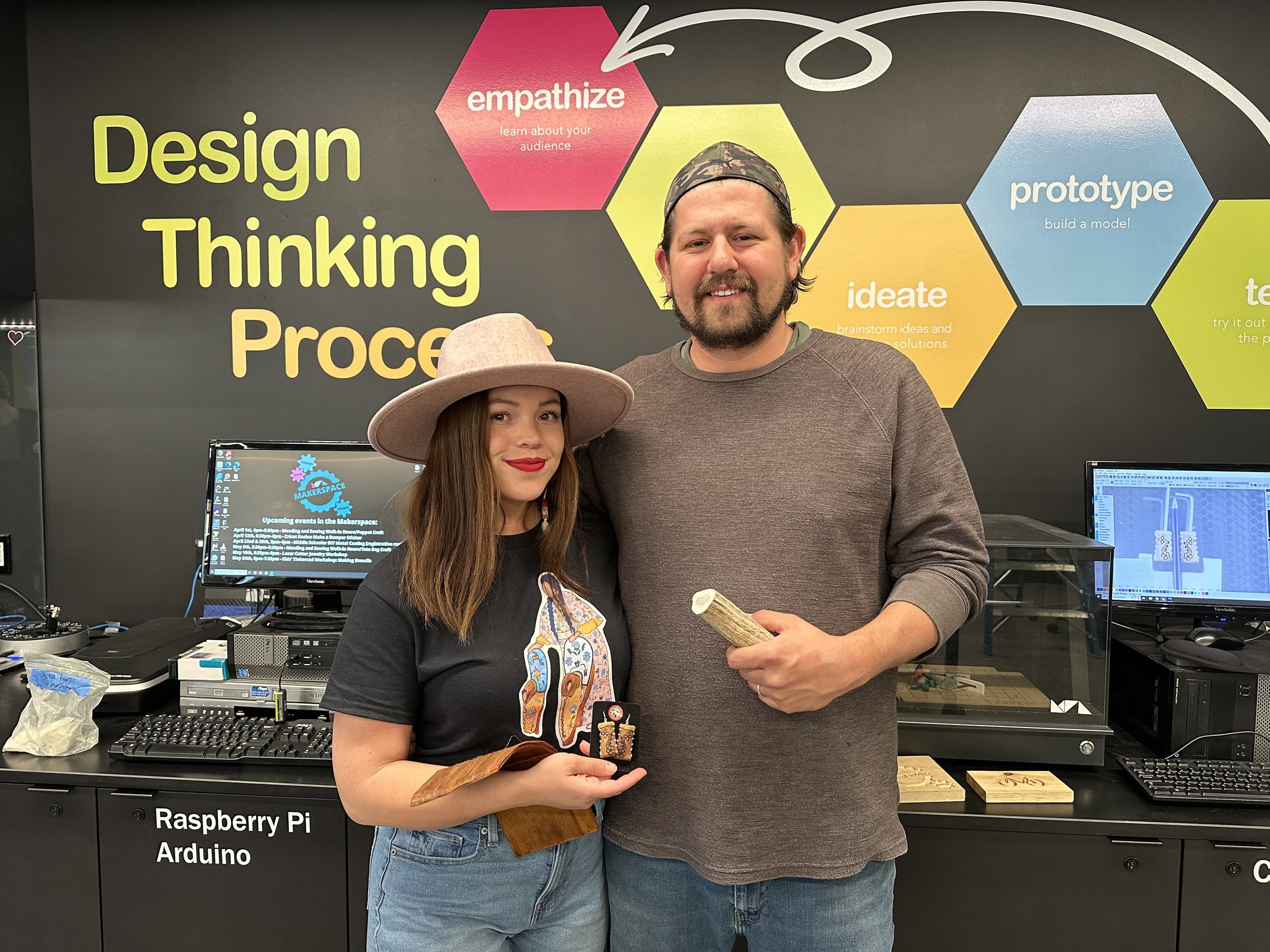Cameron Decker: SELF-GUIDED
“ I focused on Salish and indigenous tools to think about ancestral technology and contemporary technology. Time, place, tools, survival, and ingenuity were all themes that emerged through the process.”
Spring 2023 Artist-in-Residence at the Missoula Public Library
Aspen and Cameron Decker at the Missoula Public Library MakerSpace
What was your research process during your Residency at the Missoula Public Library?
Technology and AI were big topics of conversation during the residency. I approached the work with an open mind. I also knew that I would need to be self-guided and push myself to learn when I needed to answer questions. I dove into watching tutorial videos at each step that I needed them. I focused on Salish and indigenous tools to think about ancestral technology and contemporary technology. Time, place, tools, survival, and ingenuity were all themes that emerged through the process. I was over-ambitious with what I hoped to accomplish by the end of the residency, and I knew that going into it. I realized quickly that I needed to start with small steps and that the technology I was learning was immensely powerful. What I learned from the residency, which is as equally empowering as it is overwhelming, is that I can create whatever I can think of.
Bison Skull Pile by Cameron Decker
How do you think about color in general?
I love this question, and I do not know how to answer it fully. Simply put, color is a gift, and I am so grateful to be able to experience it. Color is a spectrum, and we can only see a certain amount. It makes me recognize that things outside of my reality are happening, and the color spectrum (sound, smell, and other senses, too) forces me to recognize that I cannot see everything fully. It’s one of my favorite art fundamentals to teach. Rainbows blow my mind, and I get excited whenever I see one. Seeing one usually starts the rant about how amazing colors are, which my kids have heard many times.
Digital renderings of Indigenous tools by Cameron Decker
How was your experience as an Open AIR Artist-in-Residence?
Being an Open AIR Artist-in-Residence was a profound experience that has greatly affected my direction as an artist. I was able to push myself outside of my comfort zone and challenge the way I think about myself as a maker and creative person. I was also grateful to participate as a duo with my wife, Aspen Decker, and we got to grow together as artists, which was a special experience. I love learning and gaining new skills, and getting to use cutting-edge technology was what drew me to the residency. The technology I had the chance to use were things I never thought I would have access to in my life, and most did not exist when I was a kid. There was a big learning curve and a short period of time to learn complicated technology, but the staff at the MakerSpace in the Missoula Public Library were so helpful, and I could not have done it without them.
In-progress work by Cameron Decker
Have your material choices changed over the years?
It has tremendously. I started in drawing and then in clay. Clay helped me decide to pursue being an artist. I went into teaching, and as a teacher, I had to be proficient in many forms and techniques. Teaching for over ten years at Salish Kootenai College helped introduce me to indigenous art forms. Now that I left permanent teaching and work as a professional, I am trying to settle on what I enjoy the most. I am pickier now when it comes to quality materials, and I have been interested in how to manufacture my own supplies and materials from nature. I learned how to make vine drawing charcoal, and that led to making pigments.
Digital renderings of Indigenous tools by Cameron Decker
What are you up to now (post Open AIR)?
Open AIR was an amazing time that gave me permission to spend more time on my artwork and to do so in a special place. I am most proud of being able to bring a youth art group from Arlee to the MakerSpace after the residency as a field trip. They received 3D prints of wax clay sculptures they made at home. Most had never been to the library in Missoula or interacted with a 3D printer. Because I learned and got comfortable with the space and tech, they were able to do so as well.
Now that it is over, making time to use the technology I learned has been difficult. I am hoping to purchase a 3D printer at some point to continue some of the work I was making. I did, however, buy a Cricut machine, something I detested for a long time, and I have embraced being able to use its cutting capabilities. I have been making rope out of deer sinew and tools from bones. I hope to learn how to flint knap. I have been making my own paints from rocks I find and collect. Some days I am on the computer, some days, I am working with animal hide or bones, and sometimes I am sitting on the computer while I am working with animal hide and bones.
Digital renderings of Indigenous tools by Cameron Decker
Any new projects in the works?
I have just finished up a sculpture that will be located on Main Street in Polson, MT. I created a large sculpture of a stone, an arrowhead, a log, and a trout as a tribute to its location. It is also outside of the Confederated Salish and Kootenai Tribes Natural Resources building, and I took that into consideration as well. I used a material named Pal Tiya, which is essentially a concrete clay with fiberglass that can withstand frost. I have never built anything this large or worked with this material, but I am proud of how it turned out.
Check out Cameron’s Instagram
@xwlxwilt or visit his website HERE!








